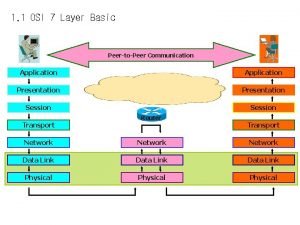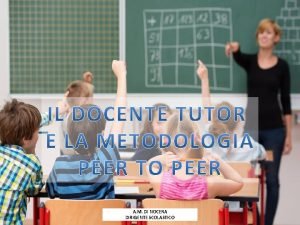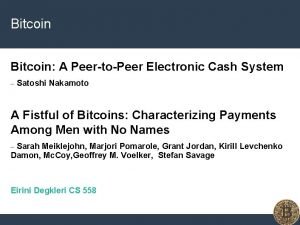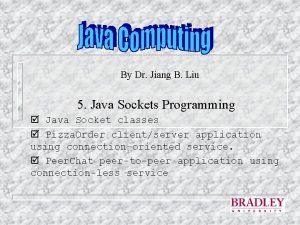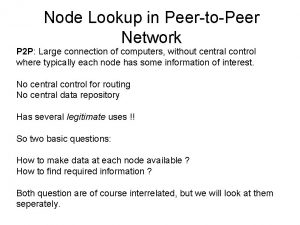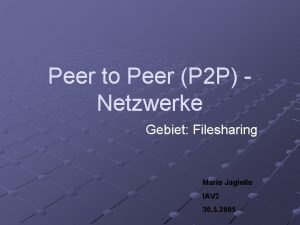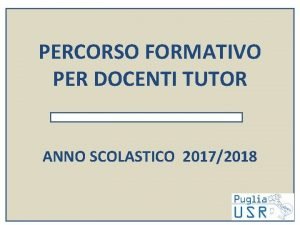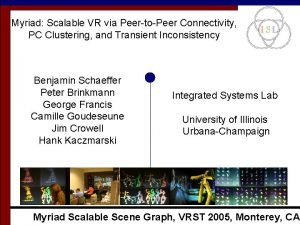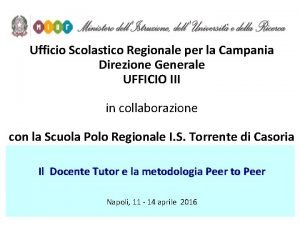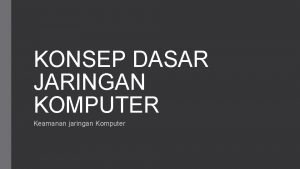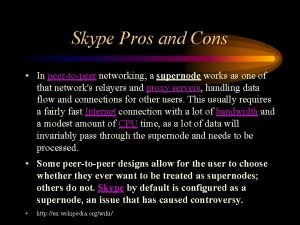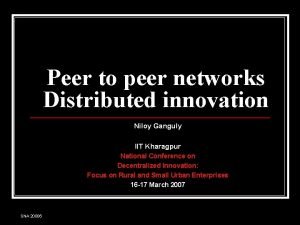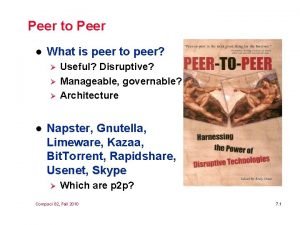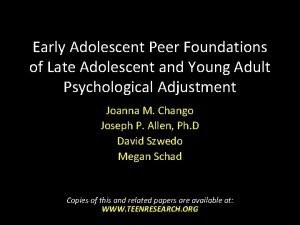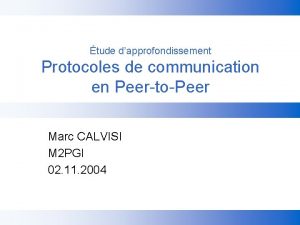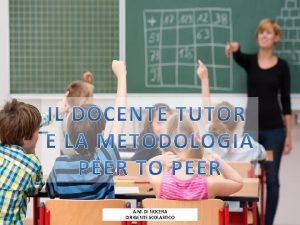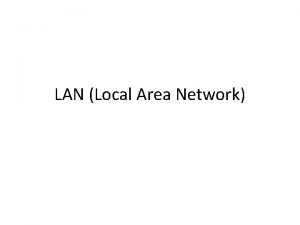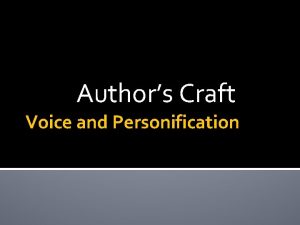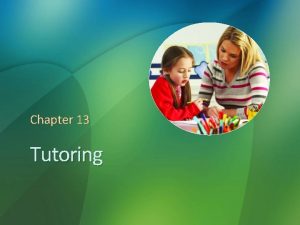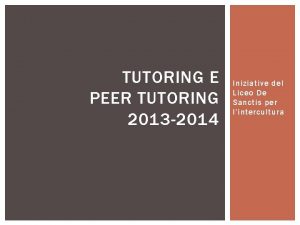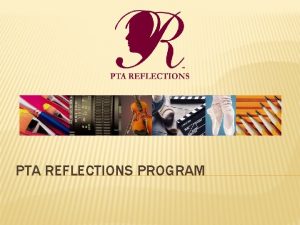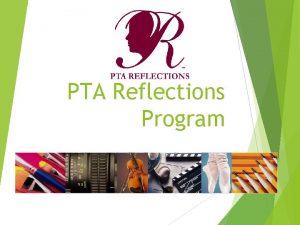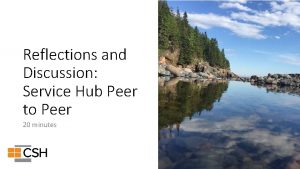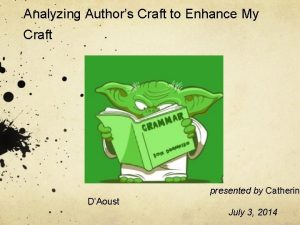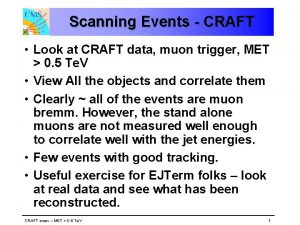Developing tutoring craft through crossinstitutional peer exchange Reflections



















- Slides: 19

Developing tutoring craft through cross-institutional peer exchange: Reflections on the inaugural Waikato-York programme Images: Rachel Clarke and James Rowan Richard Walker Head of E-Learning Development University of York, UK DEANZ Conference 2016: 17 -20 April 2016

Developing online tutoring craft: Some challenges § Pace of change – alignment of teaching methods with tools to support student learning § Adaptation from classroom to online practice: ‘unlearning’ of traditional pedagogy (Mc. William) – …and yet majority of tutors have limited or no background of online learning experience to draw upon (Bennett & Marsh, 2002) § Defining and shaping tutor identity i. e. ‘online teaching persona’ (Harper & Nicolson, 2012) and tutoring strategies § Re-envisioning of instructional role and different dimensions of instructional support to facilitate student learning (Danielsen & Nielson, 2012)

Putting pedagogy first in tutor development § Shift of emphasis from ‘how to’ (technology first) to a critical review of instructional design § Focus on process of learning: facilitating and supporting student learning. § A re-examination of approaches to teaching and learning, exploring full potential of technologies to support different pedagogical models (Kirkwood & Price; 2012)

How can peer observation contribute to tutors’ professional development? § non-judgemental / constructive dialogue on tutoring practice § opportunity to define tutoring approach and address development needs through critical dialogue and sharing of perspectives (Mc. Mahon, Barrett & O’Neill, 2007) – colleagues as mirrors, mentors or critical friends (Brookfield, 1995) § empowering to participants – control of objectives for observation – freedom to determine mode of participation (observer and/or observee)

Why cross-institutional peer observation? “…an opportunity to have a rethink about things and work with someone I have never worked with before, so there was no institutional agenda at work here, it was about growing ourselves” “…getting experience of the external culture of an institution – that was motivating. It is important to keep abreast of developments in distance learning in other institutions, to see whether the way they do things could benefit our own students. ” Waikato Tutor York Tutor

Design of the 2015 Waikato-York cross-institutional programme Shared features with COOLAID model Features specific to Waikato-York programme Choice over: • Participation (opt-in) • Focus of observation • Form of feedback • Future action Choice over: • Institution (internal or external partner) • Role (observer and/or observee) (Bennett, Lee, Lynch & Howard, 2010) No choice over: • Selection of partner although preferences over discipline & tutoring experience considered where possible

Putting pedagogy first in tutor development York participants Waikato participants • Public Policy & Management (x 3) • Health Economics (x 3) • Applied Human Rights (x 2) • Education: Teaching English to Young Learners (x 1) • History: Railway studies (x 1) School of Curriculum & Pedagogy (x 4): • Research Methods • Digital Technologies & Pedagogical Purposes • Writing for Academic Purposes • Teaching & Learning Mathematics School of Human Development & Movement Studies (x 3): • Intelligence, creativity & development of talent • Primary teacher education • Human development for educators § 8 pairings between York and Waikato tutors; 1 York – York pairing § 7 reciprocal pairings; 2 pairings focusing on ‘one-way’ observations

Key stages in the 2015 peer observation programme Blind matching of pairs (March) March 2015 Preparing for the observation Virtual introductions Definition of observation objectives 2 -3 Weeks Conduct of observation archived or 'live' course 1 Month Exchange of feedback discussion of outcomes 2 -3 Weeks Evaluation of observation Confirmation of 'change agenda' for individuals and programme team Sept 2015

Emergent modes of engagement between pairings Instrumental (task focused) Collaborative (personal exchange) Collaborative (cyclical exchange) • synchronous meeting / email exchange to confirm procedures & describe individual course contexts • objectives determined on an individual basis • synchronous discussion(s) to build rapport, before discussing objectives for observations • objectives for observations agreed through discussion • synchronous discussions to build rapport • evolving foci for a series of observations, based on shared interests and real-time teaching challenges

Engagement modes and reported outcomes “It did reinforce some of the things I had picked upon in my own reflection. She provided an answer for how I might think about doing it. She helped me to make a decision on a course of action - she influenced that. ” Waikato Tutor Task focused (driven by objectives) Rapport-based: (challenging – going beyond the agreed objectives) “Even when there were points made that were not glowing, they were telling for me and I appreciated this learning even if it highlighted an area beyond the initial observation like effective communication. ” Waikato Tutor

Are outcomes different in a cross-institutional partnership? Discussion management: encouraging student participation and meaningful engagement Personal reflection on tone / formality of the tutor voice “…she recognised how the language I used and the way I talked was much more informal than she was used to. I don’t know if that is NZ or a personality thing…. The different experiences and perspective of interactions were valuable for thinking about my teaching. ” Waikato Tutor

Activity design: Encouraging students to engage in reflective practice Institutional differences in assessment practices: challenging institutional norms and blind spots (what’s acceptable) and academic values (e. g. freedom of students to determine assessment focus) “…their willingness to have a much more varied assessment scheme than University Teaching Committee will allow us to do. That is something to talk about and I can come back with evidence. The other thing is the level of trust that X invested in her students – in contrast to the way that we go through each week – delivering a lecture and then a discussion which is very highly bound to the lecture. It is very different in New Zealand. ” York Tutor “X’s questions on the assignment – he raised questions regarding the validity as it is currently set up. He raised a question which I can put to the team and this can lead to real change in the future. ” Waikato Tutor

Technology usage and content design: tools and visual structure institutional differences in course design and technology usage: what’s possible “Without exception I get new ideas looking at someone else’s course…. an awareness of the … different tools they were using – the VLE platforms were different too… the way they were branded and customised – our Moodle platform is more boring, so this was an interesting insight – I didn’t know about that and it made me look at that. ” Waikato Tutor

Do participants associate a greater value in crossinstitutional / cross-cultural exchanges? Pros Cons (more) motivating – freshness of ‘outsider’ perspective different context offers more objective stance – no institutional agenda Commitment needed to manage virtual relationship: building rapport; overcoming practical challenges -time zones & access to learning environments Perspectives can be broader – you get a different picture of your practice Can highlight personal and institutional blind spots Institutional differences may limit transferability of observed practice and insights: value of feedback can be negligible if suggestions cannot be implemented Easier to be frank with people you don’t know Sensitivity to differences in national, institutional and course-level practice is needed to ensure a meaningful exchange (e. g. teaching across multiple time zones and challenges of introducing synchronous tutoring) Affirming about own practice & tutoring context: e. g. privileges /academic freedoms of national HE context

What are the key conditions for a productive relationship? § Growth mindset (Dweck, 2006): open orientation to professional and personal growth…. § Commitment of time: – investment in relationship building (rapport) - establishing common ground; § Effective time management: – negotiating time zones and institutional calendars § Adequate preparation: mastering “telescopic” (big picture) and “microscopic” (operational) perspectives of observed course

Further information York tutor’s reflections on participation on the 2015 York-Waikato programme: https: //youtu. be/Gy 5 DOUWDzq. U Peer observation programme: guidance resources: https: //www. york. ac. uk/staff/teaching/community/ peer-support/distance-learning-observation

Next steps § Expansion of cross-institutional peer observation § 2016 programme: collaboration between York, Waikato and Otago § Further exploration of cross-institutional, cross-disciplinary peer mentoring

Questions? Image: Bryn Jones Dr Richard Walker E-Learning Development Team University of York, UK richard. walker@york. ac. uk

References Bennett, S. ; Lee, S. ; Lynch, P. ; Howard, L. (2010). COOLAID (Collaborative Observation in the On-Line Environment for enhancement across Institutional Divides. HEA Evidence Net. Danielsen, O. , & Nielsen, J. L. (2010). Problem-oriented project studies - the role of the teacher as supervising / facilitating the study group in its learning processes. In L. Dirckinck-Holmfeld, V. Hodgson, C. Jones, M. de Laat, D. Mc. Connell & T. Ryberg (Eds. ), Proceedings of the 7 th International Conference on Networked Learning 2010: 558 - 565. http: //www. lancs. ac. uk/fss/organisations/netlc/past/nlc 2010/abstracts/PDFs/Danielsen. pdf Dweck, C. S. (2006). Mindset: The new psychology of success. Random House, New York. Harper, F. ; Nicolson, M. (2013). Online peer observation: its value in teacher professional development, support and well-being. In International Journal for Academic Development, 18 (3). Available online at http: //dx. doi. org/10. 1080/1360144 X. 2012. 682159 Kirkwood, A. , & Price, L. (2012). Missing: Evidence of a scholarly approach to teaching and learning with technology in higher education. Institute of Educational Technology, The Open University, Milton Keynes, UK. Retrieved from: http: //www. lth. se/fileadmin/lth/genombrottet/Missing_-_a_scholarly_approach. HO. pdf Mc. Mahon, T. ; Barrett, T. ; O’Neill, G. (2007). Using observation of teaching to improve quality: Finding your way through the muddle of competing conceptions, confusion of practice and mutually exclusive intentions. In Teaching in Higher Education 12 (4), (pp. 499– 511). Mc. William, E. (2005). Unlearning pedagogy. In Journal of Learning Design 1 (1), (pp. 1 -11).
 Peer-to-peer communication in osi model
Peer-to-peer communication in osi model Esempi di peer to peer compilati scuola primaria
Esempi di peer to peer compilati scuola primaria Peer intervention program
Peer intervention program Bitcoin: a peer-to-peer electronic cash system
Bitcoin: a peer-to-peer electronic cash system Peer to peer transactional replication
Peer to peer transactional replication Peer to peer chat application in java
Peer to peer chat application in java Node lookup in peer to peer network
Node lookup in peer to peer network Peer p
Peer p Relazione finale tutor tirocinio esempio
Relazione finale tutor tirocinio esempio Peer-to-peer o que é
Peer-to-peer o que é Annotazioni sulla verifica effettuata peer to peer
Annotazioni sulla verifica effettuata peer to peer Features of peer to peer network and client server network
Features of peer to peer network and client server network Konsep dasar jaringan komputer
Konsep dasar jaringan komputer Pros and cons of skype
Pros and cons of skype Peer-to-peer o que é
Peer-to-peer o que é Peer to peer l
Peer to peer l Peer-to-peer o que é
Peer-to-peer o que é Peer-to-peer
Peer-to-peer Programmazione e sviluppo condiviso compilato
Programmazione e sviluppo condiviso compilato Jaringan peer to peer diistilahkan dengan
Jaringan peer to peer diistilahkan dengan
